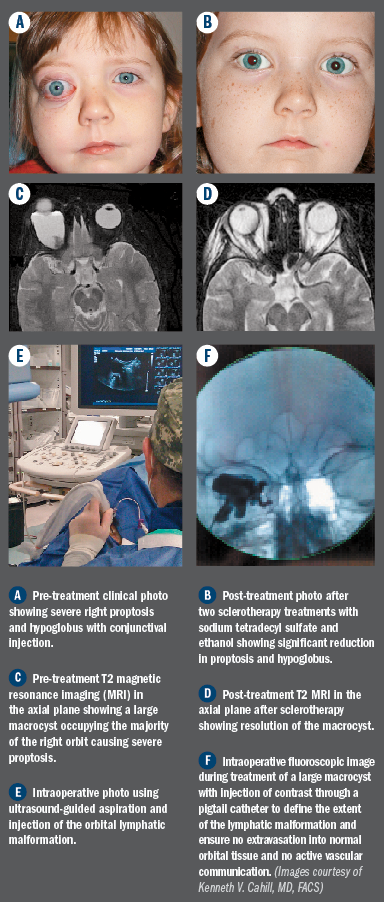Article
Tactics for treating lymphatic malformations
Percutaneous ablation of lymphatic malformations is a safe, effective alternative to surgical resection, based on extensive follow-up of a large series of cases performed at a leading pediatric hospital in the United States.
Take-home:
Percutaneous ablation of lymphatic malformations is a safe, effective alternative to surgical resection, based on extensive follow-up of a large series of cases performed at a leading pediatric hospital in the United States.
By Nancy Groves; Reviewed by Kenneth V. Cahill, MD, FACS
Columbus, OH-More than a decade of follow-up indicates that percutaneous drainage and ablation of lymphatic malformations is a safe and effective treatment approach.
Observation of a series of more than 80 patients followed up to 12 years demonstrates that the best road map for treatment is T2 images on magnetic resonance imaging, judicious use of fluoroscopy with radiation minimization, and ultrasonography for evaluation and treatment, said Kenneth V. Cahill, MD, FACS.
This minimally invasive outpatient procedure is preferable to surgical management, Dr. Cahill said.
“We find that we’re able to achieve permanent remission and decrease the progression of the fibrotic component of these lesions,” he said.

How the procedure works
The approach that Dr. Cahill, William E. Shiels II, DO, and others at Nationwide Children’s Hospital, Columbus, OH, pioneered to manage lymphangioma macrocysts (>1 cm) is to enter the lesion with an angiocatheter through which a flexible pigtail catheter is introduced.
The catheter remains in place to withdraw fluid and instill radiocontrast to confirm the extent of the cyst, make sure there is no communication of cysts within the orbit, and check for leakage around the catheter. Ultrasound can be used instead of fluoroscopy to document the catheter placement.
Once the macrocyst has been drained and its extent and intactness have been evaluated, sodium morrhuate is introduced then withdrawn and rinsed after its dwell time.
The second step is introduction of absolute alcohol, which is also then withdrawn and rinsed. Next, the catheter that had been left in place is attached to a suction bulb.
“We find that draining out any serous fluid that leaks from the de-endothelialized cyst decreases postoperative swelling and seems to improve the success rate of collapsing these cysts,” Dr. Cahill said.
Follow-up includes ophthalmic exams and B-scan ultrasound to monitor recovery. More than one treatment is necessary for most patients.
Other treatment protocols
Variation in lesions may alter the treatment protocol. Some are labeled venolymphatic, a clinical rather than histopathological description. In these cases, a bloody fluid rather than serous fluid slowly reaccumulates in the cavity, and no vascular communication can be detected radiographically. Patients with a microscopic amount of blood in their cystic fluid tend to require more treatments than those who have “pure” lymphangiomas or a non-bloody fluid.
Pupil dilation is a side effect that may occur with treatment of large retrobulbar cysts, but in all cases it has fully resolved, Dr. Cahill said.
Smaller cysts also require a slightly different approach. Instead of the pigtail probe, a small-gauge angiocatheter or double-lumen needle is used. Dual agent therapy and prolonged drainage are not feasible. In these cases, ultrasound is very helpful to determine the presence and accuracy of placement of the needle.
Another useful strategy is to use bleomycin foam mixed with albumin to monitor placement of the fluid; the foam shows prominently on the treatment ultrasound.
The foam is also beneficial because it can fill the cyst and contact the endothelial tissue lining the cyst with less of the bleomycin, Dr. Cahill said. This decreases the chance of extravasation, and the amount of bleomycin used can stay below toxic dose levels even when extensive lesions are treated.
Doxycycline foam can also be used, following the same principles as bleomycin foam, Dr. Cahill said. There is no toxicity, but doxycycline foam may cause more inflammation.
Conjunctival cysts, usually classified as microcysts, are treated with direct visualization of needle placement, using doxycycline or bleomycin foam.
“Regardless of the size, the cyst may require more than one treatment, and we may not be able to treat all cysts during a single session,” Dr. Cahill said. “There’s variable interconnectivity of cysts, and it’s best to treat the more superficial ones rather than to go through one to treat a deeper one.
“Sometimes it is necessary to limit the amount that’s treated in one session because we’re dealing with a closed space and we do not want to create a compartment syndrome,” he said.
Side effects that may occur include edema around cysts, hemorrhage from needle tracts, and serous transudate or hemorrhage inside cysts from denuded endothelial linings. Systemic corticosteroids following treatment can make the recovery easier.
In all of the cases that Dr. Cahill and colleagues have treated over the years, complications have been temporary. These include double vision, corneal exposure, increased intraocular pressure, mydriasis, optic nerve compromise, and one incident of corneal penetration.
The treatment protocol has several shortcomings, he said.
At this time, it is not possible to treat all apical cysts and intraconal cysts safely. When treatment is possible, multiple treatments may be needed, usually at 1- to 3-month intervals, and recovery from each treatment takes about 1 month.
Kenneth V. Cahill, MD, FACS
P: 614/221-7464
Dr. Cahill did not report any financial disclosures.
Subscribe to Ophthalmology Times to receive the latest clinical news and updates for ophthalmologists.
Newsletter
Don’t miss out—get Ophthalmology Times updates on the latest clinical advancements and expert interviews, straight to your inbox.




